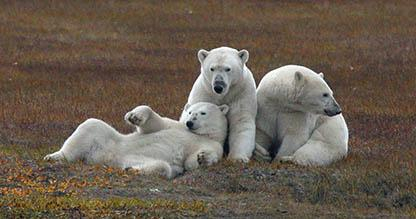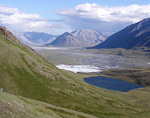 Cathy Curby, long-time ETS alumnus and coach, recently produced this interpretive handout to help her visitors at the Arctic National Wildlife Refuge in Alaska. It’s a relatively simple product, intended to be distributed to people who visit Kaktovik (Barter Island) to view Polar Bears. The refuge staff also plan to use it as a downloadable document on the refuge website, and for teachers, students, or anyone else for which a pledge like this would be appropriate.
Cathy Curby, long-time ETS alumnus and coach, recently produced this interpretive handout to help her visitors at the Arctic National Wildlife Refuge in Alaska. It’s a relatively simple product, intended to be distributed to people who visit Kaktovik (Barter Island) to view Polar Bears. The refuge staff also plan to use it as a downloadable document on the refuge website, and for teachers, students, or anyone else for which a pledge like this would be appropriate.
Although polar bears have been "overused" as a climate change icon, and the standard advice for communicators is to help audiences appreciate the effects of climate change in their own locations, the Arctic Refuge is in the opposite position because polar bears ARE their local focus. This pledge is an attempt to inspire those who come to see polar bears, to reduce their fossil fuel use for the benefit of polar bears, reminding them it will help provide benefits near visitors’ homes, as well.
A Pledge to Take Actions to Reduce Fossil Fuel Use
Background Information and Content
What’s happening to polar bears at Kaktovik, Alaska?
 Polar bears traditionally hunt across arctic sea ice for seals. In order to grow strong and stay healthy, the bears need the large amounts of fat and nutrition that seals provide. But warming temperatures in the arctic are causing sea ice to retreat many hundreds of miles away from the north coast of Alaska, and far from the shallow waters near land that the seals prefer. Now polar bears must decide whether to stay on the distant ice, with less chance to find seals, or to stay on land, where they need to locate new types of foods.
Polar bears traditionally hunt across arctic sea ice for seals. In order to grow strong and stay healthy, the bears need the large amounts of fat and nutrition that seals provide. But warming temperatures in the arctic are causing sea ice to retreat many hundreds of miles away from the north coast of Alaska, and far from the shallow waters near land that the seals prefer. Now polar bears must decide whether to stay on the distant ice, with less chance to find seals, or to stay on land, where they need to locate new types of foods.
In Kaktovik, the polar bears on land feed on the remains of whale carcasses during the village’s fall whaling season. This is not the bears’ preferred food, but it is the best alternative they can find.
What visitors can do to help polar bears.
Most of us live a long way from polar bears, but we can all take actions that help the bears, and help our own neighborhoods as well.
The problem: Humans are burning large amounts of the ancient plants we call “fossil fuels” (including oil, gasoline, natural gas, and coal). When these fuels burn, they add carbon to the atmosphere, which traps heat and warms the earth’s surface.
Actions you take to reduce your fossil fuel use will ease the problem. Here are a few that you can do.
Choosing from this list will help to make this pledge to contribute to a better world:
- Use less gasoline. Some ideas include: combine your errands so you drive less; carpool, take public transportation or walk whenever possible; try hyper-miling (using energy efficient driving techniques); keep tire pressure correct.
- Reduce the heating or cooling in your home. Some ideas include: Lower the thermostat a few degrees in cool months, insulate your windows, and wear a jacket or sweater indoors; raise the thermostat a few degrees in warm months to reduce air conditioner use, and use window shades to reduce the sun’s heat indoors.
- Include food in your energy saving mix: Some ideas include: Purchase foods grown locally to reduce transportation demands (and support local businesses); heat foods hot, then turn off stove/ microwave and insulate the pan to finish cooking; if eating beef, purchase grass-fed meat from sustainable farms (because effective livestock grazing pulls carbon out of the atmosphere and stores it in plant roots).
- Include household items in your energy mix: Some ideas include: Change light bulbs to compact florescent or LEDs; unplug electronics when not in use; air-dry clothes when possible; purchase energy efficient appliances.
This is a brief list of ways to reduce fossil fuel use. If you have other ways to reduce your fossil fuel use, add them to your pledge, too.
A warming world is a problem for all of us.
 Our society depends on the energy we get from fossil fuels. But each one of us can find ways to reduce our fossil fuel use a bit, which may help keep the Arctic cool enough for polar bears, and help us, too. A warming world is not only a problem in the arctic. It may also be causing problems closer to our own homes. Some examples you may be noticing include increases in: extreme weather events, droughts or floods; insect outbreaks; coastal erosion; wildfires; and plants blooming at unusual times.
Our society depends on the energy we get from fossil fuels. But each one of us can find ways to reduce our fossil fuel use a bit, which may help keep the Arctic cool enough for polar bears, and help us, too. A warming world is not only a problem in the arctic. It may also be causing problems closer to our own homes. Some examples you may be noticing include increases in: extreme weather events, droughts or floods; insect outbreaks; coastal erosion; wildfires; and plants blooming at unusual times.
This pledge to take actions to reduce fossil fuel use will help all of us.
It’s also significant to mention that Cathy purposely avoided the use of "climate change" or "global warming." She felt that the pledge message to reduce fossil fuel use should be the focus, without introducing the emotions and politics that may be the response to those phrases. This as a great example of a simple-to-create but highly effective handout that can directly address a significant management concern for the refuge over the long-term.
Arctic Refuge and the U. S. Fish and Wildlife Service have additional information about polar bears at https://www.fws.gov/refuge/arctic/bears.html
Related References:
For more details about these creative products:
 Cathy Curby
Cathy Curby
Wildlife Interpretive Specialist
Arctic National Wildlife Refuge
101 12th Ave., Room 236
Fairbanks Alaska 99701
907-456-0500
This email address is being protected from spambots. You need JavaScript enabled to view it.
http://arctic.fws.gov/
Facebook.com/arcticnationalwildliferefuge
